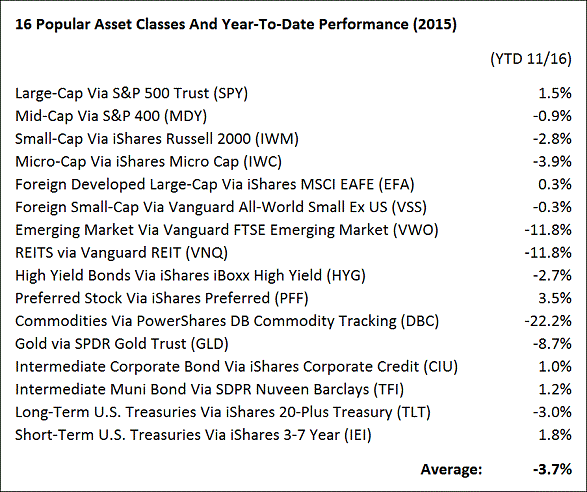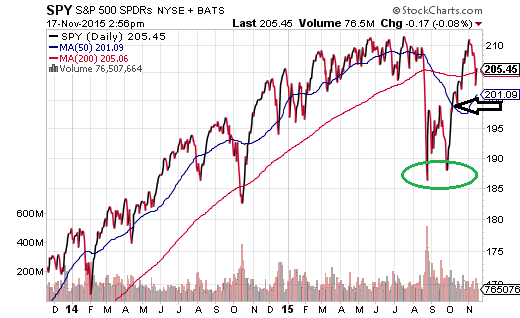According to Barry Ritholtz of Ritholtz Wealth Management, a frequent contributor to CNBC as well as Bloomberg, “the beauty of diversification is that it’s about as close as you can get to a free lunch in investing.” Since 2011, however, investors who diversified in stocks outside of the U.S. and who diversified across other asset types (e.g., commodities, currencies, gold, pipeline partnerships, etc.) have consistently underperformed the plain vanilla approach of owning the S&P 500 SPDR Trust (N:SPY) alongside a modest buffer of Vanguard Total Bond Market (N:BND).
Of course, the S&P 500 itself has struggled year-to-date (through 11/16). The price has essentially flat-lined over ten-and-a-half months at 0%. It follows that one might be led to believe that underwhelming performance in the large-cap benchmark might imply overwhelming performance elsewhere. After all, this is where diversification should shine.
So, then, has the “free lunch” of diversification finally make a comeback? Hardly. Consider the list of 16 asset types and accompanying exchange-traded vehicles in the table below.

An investor or money manager who dutifully maintained an allegiance to diversifying across asset classes (e.g., stocks, bonds, currencies, commodities, etc.) as well as within those classifications (e.g., small, large, foreign, domestic, short, long, investment grade, higher-yielding, etc.) is not being rewarded for the effort. In some corners, the risk-adjusted negative returns might be superior to the risks associated with a large-cap-only portfolio. After four years, however, faith in the free lunch of diversification may be dissipating.
It gets worse. As the end of 2015 approaches, tax-loss harvesters may decide that it is better to get rid of year-to-date losing propositions such as iShares Russell 2000 (N:IWM), Vanguard FTSE Emerging Market (N:VWO), iShares iBoxx High Yield (N:HYG), SPDR Gold Trust (N:GLD) and Vanguard REIT Index (N:VNQ). Meanwhile, the proceeds may flow back into the large-cap stock arena, where marginal gains still look better on paper than the losses from the less-than-desirable diversified results.
On the other hand, you might not want to bet the house on a Santa Claus rally for the S&P 500 either. Granted, the large-cap barometer rocketed more than 10% off its 2015 lows (1867) in October, but it has been unable to make it back to its record high (2130) set in May. Why didn’t U.S. large-company stocks fully recover? The narrow breadth in risk asset leadership has acted like an anchor on the biggest of the big corporations. In other words, if mid-caps, small-caps, micro-caps, emerging markets, foreign developed markets, pipeline partnerships, REITs and high-yield bonds are all going to get knocked out like Ronda Rousey in the “Octagon,” there’s certainly no guarantee that large corporate shares will buck the prevailing trend.
A faltering global economy (macro-econ), equity overvaluation (fundamentals) and weakening marker internals (technicals) led me to reduce risk before the August sell-off. For example, most moderate growth and income clients may have had 65%-70 stock (e.g., large, small, foreign, etc.) and 30%-35% income (e.g., short, long, investment grade, cross-over, higher-yielding, etc.). We shifted to 50%-55% equity, 25% bond, and 20%-25% cash to lower the exposure to risk assets of any kind. Equally important, we lowered the risk profile itself, where stocks were primarily domestic and bonds were primarily intermediate investment grade.

The technical retest of the September lows coupled with key moves about trendline resistance led us to bump the large-cap equity component up to 60%, while leaving the 25% investment grade and 15% cash intact. That said, the current profile is still less exposed to risk than 65%-70% growth (e.g., large, small, foreign, etc.) and 30%-35% income (e.g., short, long, investment grade, cross-over, higher yielding, etc.).
When the bulk of risk asset classes are firing on all cylinders in a strong economy with reasonable valuations and desirable credit spreads, I am more inclined to pursue the free lunch of greater diversification. Right now, however, diversification across asset types and within asset types is a hindrance.
For a 60% (mostly large-cap domestic), 25% bond (mostly investment grade) and 15% cash/cash equivalent mix, I am employing stock ETFs like iShares S&P 500 (N:IVV), iShares MSCI USA Minimum Volatility (N:USMV) and the Technology Select Sector SPDR ETF (N:XLK). I am also using bond funds like iShares 3-7 Year Treasury Bond ETF (N:IEI), SPDR Nuveen Barclays (L:BARC) Municipal Bond ETF (N:TFI) and Vanguard Total Bond Market (N:BND).
Disclosure: Gary Gordon, MS, CFP is the president of Pacific Park Financial, Inc., a Registered Investment Adviser with the SEC. Gary Gordon, Pacific Park Financial, Inc, and/or its clients may hold positions in the ETFs, mutual funds, and/or any investment asset mentioned above. The commentary does not constitute individualized investment advice. The opinions offered herein are not personalized recommendations to buy, sell or hold securities. At times, issuers of exchange-traded products compensate Pacific Park Financial, Inc. or its subsidiaries for advertising at the ETF Expert web site. ETF Expert content is created independently of any advertising relationships.
